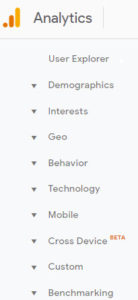Public relations professionals know all too well how hard it is to accurately report ROI in terms of a PR campaign. Unlike sales, there sometimes isn’t any concrete data to reflect how successful a campaign was, specifically if its purpose was to bolster brand awareness. Instead, a PR expert must demonstrate the value of a placement. There are several ways to do so, from analyzing social metrics and engagement to examining the reach of a media outlet, but did you know that you can use Google Analytics to further analyze and validate your PR success?
Google Analytics is a free and useful tool for digital marketing pros, but it can also be of use to those in the PR realm. All you need is access to your client’s account. Once you’re granted access, you’re able to track and analyze success in a number of ways.
PR Goal: Get people to fill out a contact form, download a whitepaper, request more information, or purchase something.
How to Track: Check the goal completions in Analytics. There needs to be a goal set up (like a thank you page) so that you can see exactly how many people completed the desired action.
PR Goal: Drive people to a specific part of your website or to perform an action.
How to Track: Congrats – you landed a media placement (or two) on a news site or blog! Educate your client on how this media hit drove relevant traffic to their site by analyzing how many unique visitors the site had during that time frame. If your goal was to bring people to a specific piece of content, Analytics can show you all the ways those users interact with that piece, whether it drove them to your site as a referral source or led them to explore and learn more about what you’re offering. Google Analytics allows you to track where users went next, how many pages they viewed on the site, how long they stayed on the site, and if they completed your call-to-action.
PR Goal: Get to know your audience.
How to Track: Any good business knows their demographics and has a specific audience they’re trying to target. In Google Analytics, you can learn even more about your audience and see if you’re leaving out potential customers. Google gathers information on the people coming to your website based on gender, location, age, etc. Maybe your client thought that Baby Boomers were their target audience, but you discover that there’s an influx of millennials coming to the website. This can lead to creating new messaging and campaigns to boost your engagement with these groups.
But wait… there’s more! Google Analytics can help PR pros in other aspects of a campaign, including:
Generate new ideas. Aside from measuring results, there’s a lot more you can learn about an audience through Google Analytics that can help frame future campaigns and PR plans. For example, you can see which pages on your client’s website are the most visited/read, A.K.A. the content that is resonating most with your audience. Use those pieces to think about future content or to create a pitch and get a reporter to cover the topic.
Track event-driven engagement. When a story is published, a contest begins, or event ticket sales start, you can put an annotation in Google Analytics. Marking this event down can help you determine if there was a spike in sales or traffic to your website afterward. You can report these numbers back to your client and showcase success.
Measure (and create more) social success. Google Analytics also allows you to see how many people came to your client’s website from social media. If you notice a lot of referral traffic coming from Instagram, this can help you strategize a way to make your Instagram even more robust with information. Track what those visitors are doing next, see what they’re interested in, and use that information to create future posts.
Remain present for potential audiences. Another way to gain new customers for your client is remarketing. Through Google Analytics, you’re able to gather information on users the moment they enter a website. With that information, you can target those specific users anywhere they go on the web and keep your client top-of-mind. Plus, the chances that those previous users will return to your client’s site increase. This is just one of the many ways PR practices pair well with an SEO strategy.
If your client doesn’t already have an Analytics code on their website, it’s time to add it! Otherwise, you could be missing crucial data that can demonstrate the value of your campaigns and make future PR efforts even better.







